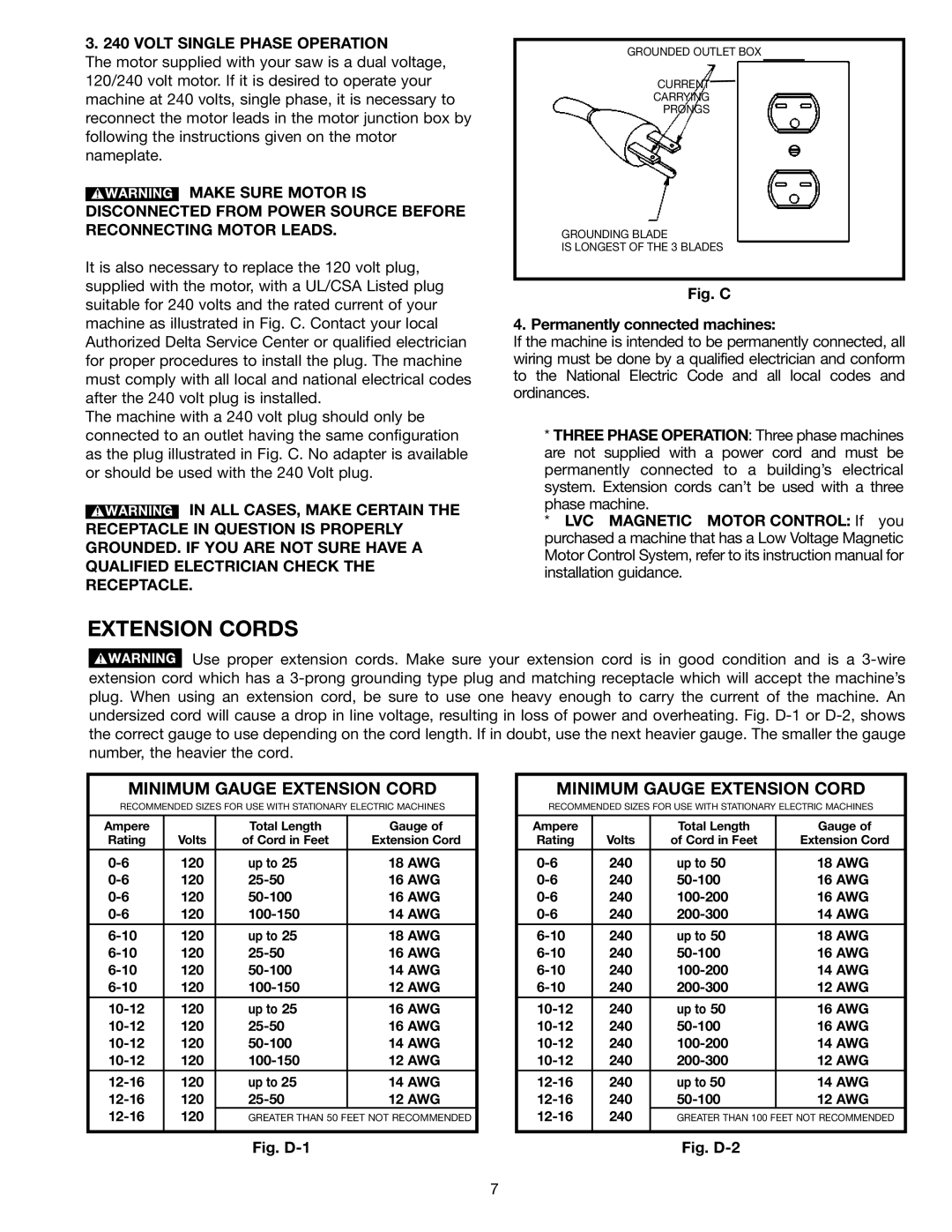
3. 240 VOLT SINGLE PHASE OPERATION
The motor supplied with your saw is a dual voltage, 120/240 volt motor. If it is desired to operate your machine at 240 volts, single phase, it is necessary to reconnect the motor leads in the motor junction box by following the instructions given on the motor nameplate.
![]() MAKE SURE MOTOR IS DISCONNECTED FROM POWER SOURCE BEFORE RECONNECTING MOTOR LEADS.
MAKE SURE MOTOR IS DISCONNECTED FROM POWER SOURCE BEFORE RECONNECTING MOTOR LEADS.
It is also necessary to replace the 120 volt plug, supplied with the motor, with a UL/CSA Listed plug suitable for 240 volts and the rated current of your machine as illustrated in Fig. C. Contact your local Authorized Delta Service Center or qualified electrician for proper procedures to install the plug. The machine must comply with all local and national electrical codes after the 240 volt plug is installed.
The machine with a 240 volt plug should only be connected to an outlet having the same configuration as the plug illustrated in Fig. C. No adapter is available or should be used with the 240 Volt plug.
![]() IN ALL CASES, MAKE CERTAIN THE RECEPTACLE IN QUESTION IS PROPERLY GROUNDED. IF YOU ARE NOT SURE HAVE A QUALIFIED ELECTRICIAN CHECK THE RECEPTACLE.
IN ALL CASES, MAKE CERTAIN THE RECEPTACLE IN QUESTION IS PROPERLY GROUNDED. IF YOU ARE NOT SURE HAVE A QUALIFIED ELECTRICIAN CHECK THE RECEPTACLE.
GROUNDED OUTLET BOX
CURRENT![]()
CARRYING
PRONGS
GROUNDING BLADE
IS LONGEST OF THE 3 BLADES
Fig. C
4. Permanently connected machines:
If the machine is intended to be permanently connected, all wiring must be done by a qualified electrician and conform to the National Electric Code and all local codes and ordinances.
*THREE PHASE OPERATION: Three phase machines are not supplied with a power cord and must be permanently connected to a building’s electrical system. Extension cords can’t be used with a three phase machine.
*LVC MAGNETIC MOTOR CONTROL: If you purchased a machine that has a Low Voltage Magnetic Motor Control System, refer to its instruction manual for installation guidance.
EXTENSION CORDS
![]() Use proper extension cords. Make sure your extension cord is in good condition and is a
Use proper extension cords. Make sure your extension cord is in good condition and is a
MINIMUM GAUGE EXTENSION CORD
RECOMMENDED SIZES FOR USE WITH STATIONARY ELECTRIC MACHINES
Ampere |
| Total Length | Gauge of |
Rating | Volts | of Cord in Feet | Extension Cord |
|
|
|
|
120 | up to 25 | 18 AWG | |
120 | 16 AWG | ||
120 | 16 AWG | ||
120 | 14 AWG | ||
|
|
|
|
120 | up to 25 | 18 AWG | |
120 | 16 AWG | ||
120 | 14 AWG | ||
120 | 12 AWG | ||
120 | up to 25 | 16 AWG | |
120 | 16 AWG | ||
120 | 14 AWG | ||
120 | 12 AWG | ||
|
|
|
|
120 | up to 25 | 14 AWG | |
120 | 12 AWG | ||
120 | GREATER THAN 50 FEET NOT RECOMMENDED | ||
|
|
|
|
MINIMUM GAUGE EXTENSION CORD
RECOMMENDED SIZES FOR USE WITH STATIONARY ELECTRIC MACHINES
Ampere |
| Total Length | Gauge of |
Rating | Volts | of Cord in Feet | Extension Cord |
|
|
|
|
240 | up to 50 | 18 AWG | |
240 | 16 AWG | ||
240 | 16 AWG | ||
240 | 14 AWG | ||
|
|
|
|
240 | up to 50 | 18 AWG | |
240 | 16 AWG | ||
240 | 14 AWG | ||
240 | 12 AWG | ||
240 | up to 50 | 16 AWG | |
240 | 16 AWG | ||
240 | 14 AWG | ||
240 | 12 AWG | ||
|
|
|
|
240 | up to 50 | 14 AWG | |
240 | 12 AWG | ||
240 | GREATER THAN 100 FEET NOT RECOMMENDED | ||
|
|
|
|
Fig. | Fig. |
7
